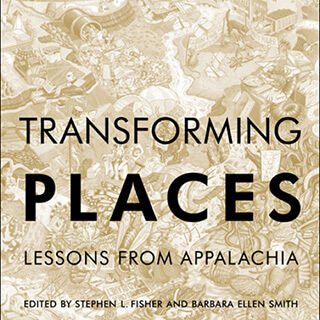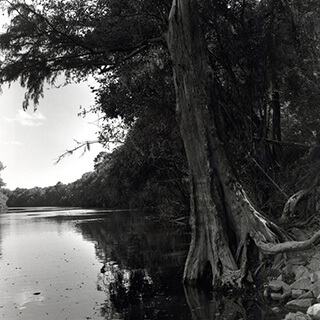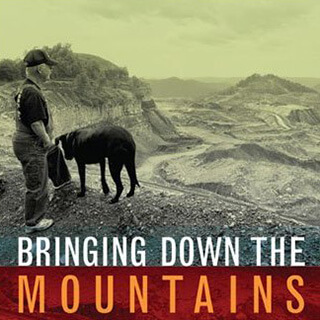Overview
Gerald Thurmond reviews Erik Reece and James J. Krupa's The Embattled Wilderness: The Natural and Human History of Robinson Forest and the Fight for Its Future (Athens: University of Georgia Press, 2013).
Review
 |
When most people consider beautiful landscapes that are worthy of saving in the southern Appalachian Mountains, they think of tall, cascading waterfalls, high, open ridges, and grasslands with dramatic vistas. Erik Reece and James J. Krupa's The Embattled Wilderness: The Natural and Human History of Robinson Forest and the Fight for Its Future tells of a more ordinary-appearing, besieged, but nevertheless precious terrain. To do this, the authors alternate chapters, with English professor Reece focusing on the environmental history of the Robinson Forest, and biologist Krupa discussing its animals, plants, and unique ecosystems.
Native Kentuckian Reece knows natural history and is committed to specific places he lives in and loves. Krupa has the writing skills and broad knowledge to describe the succession of plant communities going from the top of a ridge to the depth of a hollow: flying squirrels, the scarce four-toed salamander, the even less common Kentucky arrow darter, and the endangered, "gorgeous" Allegheny wood rat.
The southern Appalachian Mountains consist of four broad provinces: the Blue Ridge, Great Valley, Ridge and Valley, and Appalachian Plateau. The Blue Ridge is the most easterly part of the range, with mountains that average three thousand feet in elevation, but many can exceed six thousand feet. Clingman's Dome in the Tennessee part of the Great Smoky Mountains National Park and Mount Mitchell in western North Carolina rise more than 6,500 feet. This landscape is what the public usually identifies as the mountains. The Blue Ridge extends from Mount Oglethorpe, thirty-five miles north of Atlanta, through North Carolina, Tennessee, and Virginia, ending at Pennsylvania's South Mountain.
West of the Blue Ridge is the Great Valley, called the Cumberland Valley in Pennsylvania and Maryland, the Shenandoah Valley in Virginia, and the Tennessee Valley farther south. Lesser known are the other two regions of the mountains beyond the Great Valley. The first of them, the Ridge and Valley, consists of parallel waves of mountains and valleys that extend from northern Alabama to southern New York. Farther west is the Appalachian Plateau, technically not a mountain region at all, but a high tableland of sedimentary rock eroded over hundreds of millions years into knobs and steep and narrow ridgelines and coves.
 |
| Robinson forest sign in Robinson Forest, Kentucky, June 10, 2008. Photograph by Wikipedia user J654567. Courtesy of Wikimedia Commons. |
People love the higher mountains of the Blue Ridge, which is why they have put paved roads over or to the top of many of them. The Ridge and Valley—and especially the Appalachian Plateau—are the largely unappreciated and mostly forgotten parts of the southern mountains. The Embattled Wilderness is an effort to rescue what appears to be an insignificant, fourteen thousand acre woodland, the Robinson Forest, located in the Cumberland Mountain section of the Appalachian Plateau. Reece and Krupa ask "Why is Robinson Forest worth saving?" and "How should it be managed in the future?"
Since the late nineteenth century, Robinson Forest and surrounding area have had a distressed environmental history even by the standards of the southern Appalachians. In the eighteenth century the Cherokee claimed much of Kentucky as hunting grounds, but Chickasaws, Creeks, Iroquois, and Shawnee also shared the area. By the late 1700s two European families had settled in what would become the Robinson Forest, with more to follow in the 1820s. Their small homesteads didn't greatly alter the woods. Between 1880 and 1890 the first wave of large scale logging arrived, cutting trees near creeks, constructing splash dams, dragging the timber to the impoundments, and then during freshets, breaking the dams to float the logs to a sawmill. While destructive of the streams, this method only cut some species of trees hemlocks, for example, are difficult to float—and primarily those close to larger waterways.
In 1890 industrial loggers took advantage of a railway line built twenty-five miles away. Timber speculators bought up large tracts. The Mowbary and Robinson Timber Company out of Cincinnati acquired what would become the Robinson Forest. Almost all the big timber companies operating in the southern states at the time were northern. Having cut the forests in the northeast, they were looking for virgin stands.
With narrow gauge tracks laid up the creeks and a Shay locomotive, the company could cut all of the woodlands and transport the logs to mills. The skidding of the logs destroyed many of the remaining younger trees, scoured the land, and led to widespread erosion. By 1922 the company had clear-cut a twenty-three square mile area. Because the land was of no other use to Mowbary and Robinson, the company gave it to the University of Kentucky. It was called the Robinson Forest in the tradition of naming things after the people who had destroyed them.
 |
| Map showing Robinson Forest and surrounding sites of mountaintop removal and strip-mining, Robinson Forest, Kentucky, 2012. Map by Southern Spaces, created with Google Earth mountaintop removal "Extent of Mining Survey" layer courtesy of iLoveMountains.org. |
When the University got around to inspecting its new property, it found desperately poor unemployed loggers and displaced farm families squatting on it and hired a man to evict them and to destroy their shacks. The squatters responded by setting fire to the recovering woodland, establishing a habit of arson for the Robinson Forest that continues. The University initially hired local men to fight the fires. With few other ways to get money, some began setting fires to have work.
This part of Robinson Forest's history is very similar to the story of many other locations in the southern Appalachians. What sets it apart from some is the coal found in eastern Kentucky, perhaps ninety-seven million tons of it beneath Robinson Forest. As a result, a moonscape created by surface mining—Reece describes it as a "ring of death"—surrounds the Forest today.
 |
| Site of a strip mine on the south-southeast border of Robinson Forest, Kentucky, 2009. Photograph courtesy of Kentucky Heartwood. |
The technique used to get the coal, called mountain top removal (MTR), involves scraping off the top layers of earth and dumping them into a nearby hollow. Federal law requires the mining companies to either restore the land, which they never do, or to convert it to a "higher or better use" such as pasture. In practice this means leveling the land and planting it with nonnative trees and grasses. The technique destroys forests, introduces heavy metals into drinking water, vastly increases erosion and flooding, and reduces the number of many species of birds, especially wood warblers, and other rare wildlife.
Because it uses heavy equipment, mountain top removal employs relatively few people. And because it's very profitable, the technique has spread. MTR has destroyed more than 1.4 million acres, including thousands of miles of streams. Local people don't benefit. Strip-mined counties are among the poorest in the United States. Their residents suffer high rates of kidney, heart, and respiratory diseases, as well as a higher rate of birth defects.
Despite this, the Kentucky state government and much of the populace support strip mining and MTR. In his 2011 State of the Commonwealth speech, Kentucky Governor Steve Beshear called for the Environmental Protection Agency to "get off our backs." Reece reports that it is common to see "Friends of Coal" bumper stickers in Kentucky.
In 1980 the University of Kentucky proposed selling the mineral rights to Robinson Forest. Student protests prevented this, but later the rights were sold for outlying parcels. This brought in thirty seven million dollars to a scholarship fund for poor students from eastern Kentucky. Mismanaged, the fund went broke. Using the cover of restoring the scholarship money, the mining industry requested the mineral rights to the main body of Robinson Forest.
What makes the Robinson Forest worth saving are its plant and animal communities in one of the largest remaining parcels of Appalachian Mixed Mesophytic Forest. Moist, broad-leaf forest, the Mixed Mesophytic extends on the Appalachian Plateau from northern Alabama, through east central Tennessee, western North Carolina, eastern Kentucky, most of West Virginia, southeastern Ohio, and southwestern Pennsylvania.
Because this area was not glaciated during the last ice age, which ended 12,500 years ago, it became a refuge for northern plants. And its terrain of narrow ridges, coves, and good soils creates a diversity of micro-habitats. The Appalachian Mixed Mesophytic is one of the most variegated temperate forests in the world and contains the earth's most diverse temperate freshwater communities. A single site may contain thirty species of canopy trees, including pitch pines, short leaf pines, chestnut oaks, scarlet oaks, hickories, and black gums on the drier ridges, and American beech, hemlocks, rosebay rhododendron, and black willow in the wetter areas and hollows. Its creeks have many endemic species of mussels, crawfish, fishes, and invertebrates. Over the last two hundred years, ninety-five percent of Mixed Mesophytic Forests have been destroyed or substantially altered.
 |
| View of Robinson Forest from a strip mine on its south-southeast border, Robinson Forest, Kentucky, 2009. Photograph courtesy of Kentucky Heartwood. |
 |
| Strip mine on the south-southeast border of Robinson Forest, Kentucky, 2009. Photograph courtesy of Kentucky Heartwood. |
 |
| Aerial view of a strip mine on the south-southeast border of Robinson Forest, Kentucky, 2009. Photograph courtesy of Kentucky Heartwood. |
To help students recognize the rare beauty of Robinson Forest, Reece and Krupa practice a process of active learning: 1.) "see the thing"—taking students to the Forest on overnight trips; 2.) "engage the thing through representation"—reading and analyzing literature on location, but also testing streams and collecting data; and 3.) "more fully understand the thing"—examining the Forest from humanities and science perspectives and with a focus on local knowledge (54). The goal is to wean students, if only a little, from consumer culture, while connecting them to the landscape of their region.
The weekend trip can be a hard sell for students in Reece's nature writing course who'd rather not part with the Internet, cell phones, and cable television. One young woman tried to persuade her ride to fake a car accident. Reece is a patient man and says that by the second day they start to notice things.
The University of Kentucky's Agriculture Division that administers Robinson Forest has proposed clear cutting eighty five percent of the Forest's watersheds on a seventy-year rotation. This would destroy the watersheds. Despite protests, in 2007 it clear cut eight hundred forest acres around one of the cleanest and most biologically diverse streams in Kentucky to study clear-cutting's impact on water quality, again promising that money from the timber would go to the scholarship fund. The dean of Agriculture threatened that if the experiment wasn't allowed, the entire forest could be strip mined. The cut provided little money for scholarships and was of dubious scientific worth.
That Reece calls for removing Robinson Forest from the Agriculture Division's administration doesn't mean he wants the forest to go unused. Reece and Krupa suggest that the forest would make a good site for the study of the effects of climate change, and they favor forest management using a type of selective logging that could financially support the forest without destroying it.
In his foreword to The Embattled Wilderness, Kentucky poet, novelist, and environmental activist Wendell Berry argues that in the current economic and political climate no natural wonder, farm, park, or garden is safe from destruction "because by the determination of industry and the connivance of our institutions, and with the tacit consent evidently of most people, every place or thing has become merely a property exactly equaled by its market price" (ix).
Reece and Krupa hope that by taking their students to the Robinson Forest they can reverse the history of destruction. That once people experience the forest, they will develop an ethical commitment to its survival, following Aldo Leopold's land ethic: "A thing is right when it tends to preserve the integrity, stability, and beauty of the biotic community. It is wrong when it does otherwise."1Aldo Leopold, A Sand County Almanac: And Sketches Here and There (Oxford: Oxford University Press, 1949), 262.
A realist, Reece recognizes the political power of large industries, and quotes Berry's saying that whoever takes on the coal companies must "accept heartbreak as a working condition" (4). Most of the time the companies will win. And he understands that stopping mountain top removal morally and politically requires education, training, and new kinds of jobs for Appalachian people. The Embattled Wilderness offers an antidote for despair, a bit of hope amid the heartbreak. Despite the odds, and for now, Robinson Forest remains. 
About the Author
Gerald Thurmond is professor and chair of the sociology department at Wofford College, Spartanburg, South Carolina. He is the editor, with John Lane, of The Woods Stretched for Miles: New Nature Writing from the South (University of Georgia Press, 1999). Thurmond has published numerous essays and interviews on environmental subjects and is currently working on a book about snakes.
Recommended Resources
Text
Bolgiano, Chris. The Appalachian Forest. Mechanicsburg, PA: Stackpole Books, 1998.
———. Living in the Appalachian Forest: True Tales of Sustainable Forestry. Mechanicsburg, PA: Stackpole Books, 2002.
Brown, Margaret Lynn. The Wild East: A Biography of the Great Smoky Mountains. Gainesville, FL: University Press of Florida, 2001.
Davis, Donald Edward. Where There Are Mountains: An Environmental History of the Southern Appalachians. Athens, GA: University of Georgia Press, 2003.
Davis, Mary Byrd, ed. Eastern Old Growth Forests: Prospects for Rediscovery and Recovery. Washington, DC: Island Press, 1996.
Reece, Erik. Lost Mountains: A Year in the Vanishing Wilderness; Radical Strip Mining and the Devastation of Appalachia. New York, NY: Riverhead Trade Press, 2007.
———. "Hell Yeah, We Want Windmills," Orion. July/August, 2009.
———. "The Schools We Need," Orion. September/October, 2011.
Weidensaul, Scott. Mountains of the Heart: A Natural History of the Appalachians. London: Fulcrum Press, 2000.
Williams, John Alexander. Appalachia: A History. Chapel Hill, NC: University of North Carolina Press, 2001.
Web
Kentucky Heartwood. http://www.kyheartwood.org.
University of Kentucky Summer Environmental Writing Program. http://www.uky.edu/AS/English/courses/sewp/.
World Wildlife Federation. "Appalachian Mixed Mesophytic Forests." http://worldwildlife.org/ecoregions/na0402.
Similar Publications
| 1. | Aldo Leopold, A Sand County Almanac: And Sketches Here and There (Oxford: Oxford University Press, 1949), 262. |
|---|



